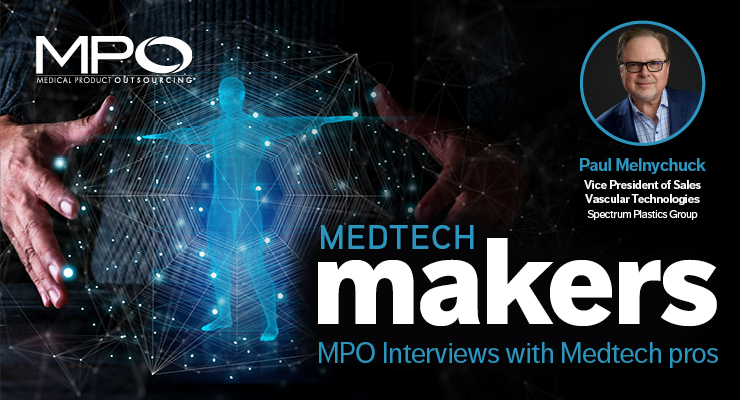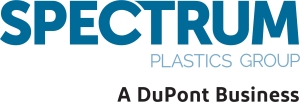Medical device OEMs are more and more moving toward partnering with full-service providers who can offer them design and development capabilities alongside the traditional contract manufacturing and component fabrication services. Working with a “one-stop shop” that can address the full range of needs offers a number of benefits, from cost controls to easier management of the supply chain.
Since these firms provide design and development competencies, it is important to meet with them early in the project timeline to take advantage of their breadth of experience. If too many design decisions are locked down before bringing in this valuable partner, the development benefits they can provide are reduced.
Offering additional insights into best practices for medical device OEMs working with a design and development partner is Paul Melnychuck, Vice President of Sales—Vascular Technologies for Spectrum Plastics Group, a firm that delivers capabilities for the design, development, and manufacture of specialty medical plastic products. The company provides standard and custom components, sub-assemblies, and finished devices to medical device manufacturers and end-users across blood and fluid management, cardiology, vascular, orthopedic, ophthalmic, and many other health applications.
Sean Fenske: When it comes to a full-service outsourcing provider serving the medical device manufacturing industry, what do design and development offerings entail?

While the phase gate process may vary across companies, they all must include concept feasibility/market assessment, design requirements/inputs, design drawings/models, design verification and validation, production readiness, commercial transfer, post-market launch/customer support, and complaint handling.
Fenske: What are some reasons it’s beneficial to gain access to these types of services from a single vendor?
Melnychuck: A vendor of these services likely has the breadth of experience from completing many such commercialization launches, to offer a realistic cost and time estimate for the project. Further, strong communication between project management, engineering, quality, regulatory, commercial, and operations will likely result in the most efficient delivery of the project deliverables, on-time and in budget.
Fenske: Do customers want to be involved with the development of their device/technology? If so, how do you make this happen (e.g., tools, software, other technologies used)?
Melnychuck: In the early commercialization phases, the customer will likely be more heavily involved with clinically-informed details, design concepts, and the development of a regulatory strategy. As the development process progresses, design concepts are translated into workable 3D models through the use of CAD modeling software. Completed drawings and model files enable the development of rapid prototypes through 3D printing, or through a partner who specializes in prototype tooling and components. Sometimes the customer may have already developed draft documentation or crude prototypes to test their design concepts. Having any of these physical assets already in hand offer a head start to the project and are viable points of entry. Close collaboration and alignment between the customer and the supplier are maintained through weekly team calls, joint design reviews, collaborative device testing, and sample review iterations.
Fenske: Why is it important to consider design for manufacturability (DFM) early in the development process?
Melnychuck: DFM drives the business case and market viability of new products. DFM can’t be an afterthought because it starts with the design, materials, and tolerances of every component and discrepancies only compound as the entire system comes together. Further, the most expensive aspect of a high volume, single-use medical device program is the production tooling of the parts. Understanding any challenges in repeatably producing the parts at scale, and with a minimum of scrap, is essential to satisfying unit cost assumptions and a program’s business plan. Being able to reliably and consistently manufacture the parts is a crucial step in ensuring the assumptions made in the design phase are met. Testing these assumptions early on through DFM is a continuous process of review and refinement to ensure the project assumptions are met.
Fenske: What are the benefits of gaining input from representatives from other areas of the production team (e.g., manufacturing, quality, regulatory, etc.) during development?
Melnychuck: Cross functional support and alignment is the foundation to a successful project. Gaining the feedback of all functional areas throughout the project ensures a minimum of unwelcomed surprises as a project nears completion. It’s critical that each functional area reviews and approves critical milestones at each step, as decisions and outcomes will once again compound as it progresses. Example development activities including tooling design, fixturing, validations, testing (e.g., biocompatibility, physical stress test), sterilization protocol development, work instructions, and operator training—all elements best addressed by the cross-functional team in a coordinated fashion.
Fenske: When working with a full-service provider of design and development, how does the OEM ensure quality remains high without being able to inspect regularly as if it were in-house?
Melnychuck: Most organizations have a quality management system (QMS) that offers common framework for alignment on quality requirements, inspection methods, and equipment, so that each company can speak the same language when managing quality, and all of which are examined during a quality audit. A full-service provider of design and development services should support an audit upfront to ensure each party’s respective QMS is reconciled. A successful customer audit history also forms the basis of a vendor being named as an “approved supplier” for such services. With its global network of ISO 13485 certified plants, a successful FDA audit history, the use of respected and stable NSAI as our European notified body, and an enterprise-wide QMS, Spectrum Plastics Group is a world class organization that delivers on quality, harmonized with customers’ regulated standards.
Fenske: What are the advantages of working with a full-service outsourcing provider when the OEM is ready to move a design to full production?
Melnychuck: First, a company may choose to outsource these services based on the reality that they do not have the resources in-house. This may be the case with a startup that will oversee the project but rely on an outsourcing strategy to select a full-service partner. Second, the selection is made based on the unique competencies and experience of the vendor, especially in niche or specialized medical applications. Third, while a company may have these resources and competencies in house, priorities or urgent remedial actions elsewhere may require an in-house all-hands-on-deck commitment. Lastly, selecting a full-service outsourcing provider serves as a risk mitigation strategy for a new and unproven program where the ROI is not completely known, or developed.
Medical device companies choose Spectrum Plastics Group, as we have an established design and development capability coupled with deep experience in manufacturing within regulated markets. We provide turnkey solutions—from concept through scaled manufacturing—in a timeframe and cost structure that is superior to their own. This expertise, bundled with continuity in program management, enables the customer to de-risk the program launch, as the bugs are more likely to be worked out through this integrated approach.
Fenske: Do you have any additional comments you’d like to share based on any of the topics we discussed?
Melnychuck: To summarize, we’ve reviewed the benefits of combining full design and development services with ISO 13485 contract manufacturing that includes an integrated supply chain of medical device components such as medical extrusion, precision molding, balloons, and high-value assembly. This full-service approach offers risk mitigation through cross-functional support from the onset, customer-supplier alignment on timeline and budget through regular communications, and a robust quality management system a customer can manage remotely. A single-source vendor such as Spectrum Plastics Group can deliver the total package, ensuring program launch success.
Learn more about Spectrum Plastics Group >>>>>














